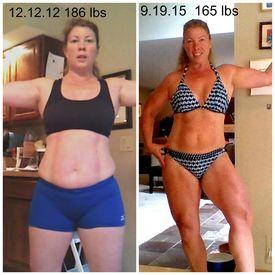TDEE deficit with heavy lifting

janelleduah1
Posts: 8 Member
Does the optimal TDEE deficit depend on the type of exercise you are doing? I am mostly doing heavy lifting, and the worksheet suggests a 20% deficit, while when I was doing mostly HIIT workouts, it suggested a 10% deficit. My BMR is 1500 and the 20% deficit is suggesting 1640, is that ok? I don't want to eat away any muscle/thwart any progress.
0
Replies
-
From my understanding, if you're doing mostly lifting/weights/resistance training then you can cut a steeper deficit in your diet without risk of losing muscle because you're body is constantly working to build and improve muscle tone through your exercise anyway.
I do crossfit 8-10 times a week so am doing about 80% heavy lifting/resistance training and 20% (actually probably less) straight cardio in short bursts, so the spreadsheet gave me a 18.6% deficit.
As long as your numbers are accurate, I'd say the figures the spreadsheet is giving you is fine, but if you're unsure you can always do a 15% cut and then you have a bit more wiggle room if you want to see faster results, etc...0 -
If you are eating TDEE method, and you have choose the correct activity level, your deficit shouldn't change regardless of what workouts you are doing.0
-
If you use the spread sheet HeyBales posted, which is what most people do, your TDEE deficit does change depending on type of exercise. It seems as if the deficit is calculated based on a heavy lifting to cardio ratio. I was wondering if that was valid. I guess I'll try this 20% deficit and see what happens.0
-
It is a weight loss calculator, not an workout improvement calculator with side goal of weight loss.
So the steepest deficit possible is based on a study shown on the TDEE Deficit tab for that amount of deficit.
They actually gained LBM while eating at that steeper deficit.
Since the goal of the worksheet is to help retain LBM, that ability to add LBM counts as an ability to retain.
2 big differences compared to the study.
1 - The study was willing to go below BMR for eating goal, the worksheet stops at BMR at bare minimum, and you'd have to be obese to get to that point.
2 - The study was very simple strength training, the worksheet only uses that deficit if you put in activity calc the heavier type of lifting.
Where as HIIT is high cardio for it's bigger cardio burn, and while in reality if done correctly it's a lifting type workout, it's rarely whole body, but very specific to muscles used.
So it would be more risky to take a big deficit.
So you can view it as biggest deficit, or lowest eating level you'd want to go.
And since lifting doesn't raise the TDEE much, it can feel like a low eating level, compliance may be an issue.
But if you want to lose the weight and can keep the goal, it'll work usually.
But you can always eat more, because with lifting, your body is going to want to make improvements, and you are not going to be feeding it what it wants - it will be hungry.0 -
I have not, nor has any of the creators of EM2WL, used the mentioned spreadsheet. We use the Scooby calculator which is based on your activity level.If you use the spread sheet HeyBales posted, which is what most people do, your TDEE deficit does change depending on type of exercise. It seems as if the deficit is calculated based on a heavy lifting to cardio ratio. I was wondering if that was valid. I guess I'll try this 20% deficit and see what happens.0 -
Hi, and welcome to the fam!!
I use a TDEE calculator (like Scooby) to figure out my TDEE based on activity level (as TDEE calculation should do). Since activity level is already included, I don't raise or lower my deficit based on my activity that day. I just eat the same daily for simplicity.
Some other members choose to use their BMF or fitbit to figure out an average TDEE and reduce accordingly. (again, just eating the same amount daily, as activity is already figured in.)
I also don't go above (or recommend more than) a 15% deficit (I'm usually 9-10% on average). 20% usually isn't necessary. The closer you are to goal, the LESS of a deficit you should have (just FYI)
Best of luck! You'll love this method!
~Kiki0 -
Well, all the 5 level TDEE systems base activity level on your best choice, which could be close, could be far removed.
Of course we know the extremes - calories burned in 1 hr of walking is not the same as 1 hr of running as 1 hr of lifting.
And 3 hrs of gym classes a week on top of a sedentary desk job is not the same as 3 hrs on top of being a nurse at a hospital for 50 hrs weekly.
Someone walking their dog 7 hrs weekly and a desk job would have a greatly inflated TDEE if they selected Very Active.
And a nurse in hospital doing 3x 45 min weekly intense spin classes a week would be greatly deflated TDEE if they selected Lightly Active.
Neither is starting off on the best foot, if by best foot we mean having a reasonable deficit from a best estimate TDEE. Former likely would have none to little, latter would be too great.
And the results during a reset eating at that TDEE would be terrible for the former, and not really a reset for the latter.
Spreadsheet is using current studies and comparison to walking along with planned weekly time at various intensity levels to better estimate activity level and TDEE. The number using FitBit's and BodyMedia's that are surprised they match so close is always a nice confirmation it is working well.0 -
I just wanted to say that I have found Heybales worksheet more comprehensive than all of the other simple calculators out there. It is a bit more in depth in the number of formula based calculations....which makes it a bit more work. But for accuracy? Hard to beat!
With that said....I have as yet to go with a 20% deficit. I am just now starting off on a 10-ish% defecit. HTH...and welcome to EM2WL!!!0 -
Hey everyone! I'm not new to EM2WL. I've been around here for at least a year but post questions whenever something changes, just ti make sure I'm doing it all correctly. I agree with HeyBales that lifting affects your TDEE less than cardio would, which is why I've always used his spreadsheet to calculate my TDEE since it takes an accurate account of my activity. Maybe not everyone is using it, but it is popular on this forum. I had akways abided by the TDEE-15% recommendation, but just noticed that the spreadsheet gives its own TDEE deficit. And in my case was actually above 20% so I decided to check back with everyone here. I'll definitely try to stay within a 10-15% deficit for my sanity's sake, but using HeyBales' TDEE calculation. Thanks, everyone!!0
-
Hey janelleduah1, I noticed you already got to a decision but I just wanted to pop in and say I'm doing the same as you with good results. I prefer to use the spreadsheet on top of the other TDEE calculators as it seems to be the most adequate. But it also gave me a -20% recommendation. Currently I'm eating TDEE-15% and I have been loosing weight and size pretty regularly and I wouldn't eat at a bigger deficit. My body needs to eat frequently to be nourished and I'm actually thinking of increasing my calories... maybe xD I still have a lot to loose!0
-
Thank you so much for letting me know it works for you! I'm trying out the TDEE-15% deficit this week and noting down any changes, good or bad. I have about 10 lbs to lose so I might up my calories to just a 10% deficit.0
-
Yes, the closer you get to your goal, the smaller your deficit should be. Also consider taking a TDEE break every four weeks as well now that you are so close to your goal.0
-
Thanks, Lucia! I completely forgot about TDEE breaks.0
-
I find that I get hungrier when I lift than when I do cardio, so my deficit has to be smaller. When I finish the program I am on, I may have to ease up a bit so I can cut to get rid of the rest of the (very stubborn) ab fat.0
This discussion has been closed.







